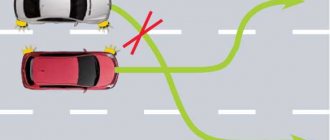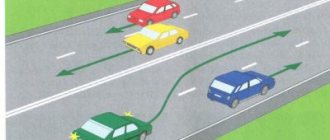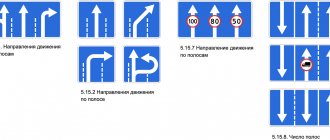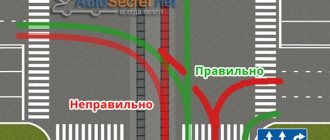Who is required to give way?
| 1. | Truck driver. |
| 2. | Driver of a car. |
The "End of lane" sign informs about the end of the lane. Consequently, the driver of a passenger car will have to change lanes to the left, and when changing lanes, he will have to give way to a truck moving in the same direction without changing lanes.
How to determine the culprit of an accident when changing lanes?
When determining who is at fault for an accident while changing lanes at the same time, they first find out who was closer to the right edge of the road. This driver had an advantage and the one who did not yield to him is automatically considered to be the culprit of the accident.
Moreover, for the car that was driving on the left, it doesn’t even matter that it was giving a signal or was in front of the opponent. In any case, the “interference from the right” rule applies. This is a simplified name for the well-known clause 8.9 of the Russian Traffic Regulations. Even if the driver who has the right of way turns out to be without a license or in a state of intoxication, and they do not yield to him, he cannot be found guilty in such an accident while changing lanes at the same time.
When changing lanes to the left, the driver who did not yield to vehicles driving without changing their trajectory is considered to be at fault for the accident.
There are many controversial situations, for example, when two cars in the same lane change lanes at the same time. In such a situation, to identify the culprit, it is necessary to clarify who first turned on the turn signal, the speed of each vehicle, and keeping the distance.
Who should give way?
| 1. | Driver of a car. |
| 2. | Truck driver. |
Since there is a narrowing of the road ahead, as warned by the “Narrowing of the Road” sign, the truck driver will have to change lanes into the adjacent lane, and when changing lanes, he must give way to a passenger car moving in the same direction without changing the direction of movement.
How to avoid accidents when changing lanes?
In order not to become the culprit of an accident when changing lanes or simply not to get into an accident, experts recommend remembering and strictly following several rules:
- You should stick to the right side of your line. This gives you more freedom to maneuver and reduces the risk of collision. Then, when changing lanes on the left, even if you have to run over the markings, in the event of an accident the car that was changing lanes on the left will be found guilty. And when maneuvering, there will be room on the right to give way to the priority vehicle.
- If you have no intention of changing lanes, you should not enter the lane markings. Often, the road situation develops in such a way that you have to drive onto the median. But practice shows that getting back into service is not easy and the vehicle has been in a state of rebuilding for a long time. In the event of an accident, there is a high chance that the driver of this car will be found guilty.
- Always before a maneuver, carefully analyze the road situation, and, if possible, assess the expected movements of other vehicles.
- When changing lanes, you should evaluate how safe the chosen maneuver is. To do this, you need to look around in the side and rear mirrors. This will give you the opportunity to see what is happening in the next lane and behind you.
- Change lanes smoothly, without jerking, so that other road users can predict the situation.
If you follow these simple tips, you can minimize the risk of getting into an accident when changing lanes.
As a result of the entire article, a skilled driver should remember several main points:
- if a simultaneous lane change maneuver is performed, then the car on the right has priority according to the “right hand” rules;
- We must not forget to turn on the light signals when changing lanes;
- You should not enter the markings if you have no intention of changing lanes;
- It is mandatory to give way to a car that is moving without changing direction.
In this case, there will be no risk of getting into an accident when changing lanes. It is also necessary to insure the car so that in the event of an accident and recognition of guilt, there is an opportunity to compensate for the damage to the victims.
The driver of a car changing lane to the right lane in this situation:
| 1. | Must not interfere with a car moving in the right lane. |
| 2. | Has an advantage because it completes the overtaking. |
The driver of a car changing lanes, including completing overtaking, must not interfere with a car moving in the same direction without changing the direction of movement.
Traffic rules when changing lanes
When a driver decides to leave his lane, it is important not only where he changes lanes, but also other nuances, including speed and maintaining distance.
There are several traffic rules that must be remembered when performing a lane change maneuver:
- The driver is obliged to warn about the start of the maneuver using turn signals. If the signals do not work or are missing, the sign is given by hand.
- When performing a lane change maneuver, you must give way to someone moving without changing direction. This applies to cars that move in their lane and do not maneuver.
- If several cars move at the same time, then the vehicle on the right has priority.
- If during a lane change the bus leaves the stop, then cars must also let it pass; public transport has priority.
All these nuances are discussed in clauses 8.1 and 8.4 of the SDA. But difficulties still arise when performing the maneuver, and then when finding the culprit in the accident. Many details depend on the specific driving situation.
Changing the car to the right lane.
This is the simplest option for changing lanes, which is clearly specified in clause 8.4 of the traffic rules. The driver is required to turn on the turn signal and let all vehicles moving on the right in their lane pass. Only then is the vehicle allowed to complete the maneuver. All vehicles have an advantage over the car in the left lane when maneuvering.
Changing lanes from the right lane to the left.
In this situation, everything is more complicated. If a driver changes lanes from the right to the left, he is obliged to give way to those who are moving in their lane and do not change direction.
If a car simultaneously maneuvers from the left to the right lane, then it must yield. In this case, priority is given to cars changing lanes to the left.
In this situation, in order to continue driving in a forward direction, you are allowed to:
| 1. | Pass the truck on the right. |
| 2. | Continue driving only after the truck makes a left turn. |
| 3. | Any of the above actions is permitted. |
To continue moving, you have the right to perform any of the listed actions. It should be taken into account that when changing lanes to the right, you must give way to all vehicles moving in the same direction.
Who should give in during a mutual restructuring?
If two cars make a lane change maneuver on one section of the road, the situation becomes more complicated. It is necessary to clearly understand the rules and understand who has the priority of movement at the moment.
The main current law for mutual restructuring is “interference on the right”, clause 8.9 of the Traffic Regulations of the Russian Federation.
If a maneuver is made by one car into the right lane, and the other into the left, then according to the rules of “interference on the right”, the first one must allow it to pass. But drivers, even with an advantage, need to make sure that the road is given way to them. It is also important to observe the speed limit, since road users are guided by a certain speed. If you brake or accelerate suddenly, a dangerous situation arises.
In any case, you should adhere to the speed limit and be extremely careful when performing a maneuver, assessing the situation in the rear-view and side mirrors. You need to change lanes only after making sure it is safe.
Types of rebuilding
A maneuver such as changing lanes can be performed in four ways, depending on the relative position of the cars and their location relative to the target lane:
- The simplest lane change is performed when two cars are moving in different lanes and one of them changes lanes to the other.
- Changing lanes at the same time - one car moves into the left lane, and the other into the right.
- Simultaneous lane change: performed when both vehicles change lanes from different lanes into one (middle) lane.
- Changing lanes in one lane: performed when two cars from one lane alternately change lanes into another.
More on the topic: What happens if you forge an electronic MTPL policy?
So who should yield to whom in each situation? Let's look at them using specific examples.
The simplest rebuild
How such a lane change should be carried out is described in paragraph 8.4 of the traffic rules. All motorists should know that the person changing lanes (if the other vehicle is moving straight ahead without maneuvering) must yield.
It is quite obvious that in the situation in the picture the driver of the blue car must yield.
It is assumed that when you change lanes, you should not force the other driver to change their speed or trajectory. Violation of one of these conditions means non-compliance with traffic rules. Note that non-compliance occurs only when the trajectories of vehicles intersect in time and space.
Let's give an example. You drove around a small obstacle in your lane, not intending to change lanes, but did not turn on the turn signal and did not cross the marking line. The driver behind you interpreted this incorrectly and swerved in the same direction. Essentially, you forced him to adjust his direction and perhaps his speed. However, a traffic violation in this case cannot be recorded, because the intended trajectories of your cars did not intersect.
Remember that turning on the turn signal does not provide any advantage.
Changing lanes at the same time
If in the previous case you need to yield only in the case when another car, whose movement path intersects your maneuver path, moves in a straight line, then in this case the second part of paragraph 8.4 of the traffic rules applies.
The driver of the blue car already has an advantage here, since he is on the right.
Changing lanes at the same time
If two cars change lanes into one (middle) lane from other lanes of the highway, the “right hand” rule also comes into force. According to it, the driver of a red car, who is to the left of the lane into which he is about to change lanes, gives way:
In the same row
It happens that a different situation arises: two cars moving in the same lane change lanes into another lane - the same for both cars.
In this case, we can talk about changing lanes only if the trajectories of vehicles intersect, that is, one car is traveling faster than the other.
More on the topic: New certificate of accident from October 20, 2021
In this case, both road users are obliged to prevent interference with the traffic of vehicles located in the target lane. Thus, the driver who did not have time to change lanes first is obliged to yield.
Rebuilding: general rules
First, let's figure out what a rebuild is and how to carry it out correctly.
In traffic regulations, changing lanes means leaving a vehicle from an occupied lane or row while maintaining the original direction of travel.
The basic rule for rebuilding a vehicle is fixed in paragraph 8.4. Traffic rules of the Russian Federation . Its essence is that, when changing lanes, the driver is obliged to let a vehicle moving in the same direction pass.
If cars moving in the same direction intend to change lanes at the same time, then the driver must let the car moving to his right pass.











